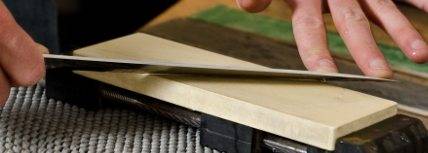Interviews
Interview with Albert Edmonds, from Seattle Edge Sharpening
18.02.2016
Here’s our interview with Albert Edmonds, owner and sharpener at Seattle Edge Sharpening.
1. Can you tell us a bit about yourself? How did you start sharpening knives?
[box size=”large”]My interest in knife sharpening started at a young age. My Father showed me how to sharpen an old fishing knife in the garage when I was eight years old and I was amazed. He was a wood worker, hunter and fisherman so knew his way around a blade. From that day forward I was fascinated with knives and sharpening. I played around with sharpening as a hobby which led me to work at a local knife store when I was 19 (2000). After much pleading they started teaching me professional sharpening and the journey began. I’ve been involved in sharpening in some way ever since.[/box]
2. How long have you been doing it?
[box size=”large”]I started Seattle Edge in 2009, and went full time in 2011. I’ve done just about every job under the sun but always came back to sharpening, either as a hobby or semi-professionally. In 2009 I decided to start Seattle Edge and sharpened on the side as I missed sharpening professionally. In 2011 I came to a fork in the road. I had the option to make the hospitality industry a long term career, but saw potential in Seattle Edge. After a lot of thinking, I decided to stick with the business and leave the hourly job. I sharpened for the knife store full time for two years and have been full time with Seattle Edge for 5 years; so 7 years cumulative full time professional sharpening. [/box]
![]()
3. Could you tell us more about you sharpening process?
[box size=”large”]My process and technique depends on the type of knife I’m sharpening. The majority of knives I give a polished yet slightly toothy edge; one that can both slice and shear in the same cut. I am a big fan of the convex edge, it can give the cutting edge extra support under stress and touches up quickly (depending on the blade steel). The tools I use are variable speed and water cooled to ensure the temper isn’t taken out of the knife, essentially “burning” the blade. Traditional, hand made Japanese knives are sharpened exclusively on water stones. My typical stone progression starts at 400 grit, a few passes on an 800 to decrease the scratch pattern created by the 400, then on to the 1000 grit, a few quick passes on a 3000, quality time on my 6000 and finishing passes on the 8000, followed by a strop.[/box]
4. How long did it take you to master it?
[box size=”large”]The pursuit of mastery is what pushes me forward as a craftsman.[/box]

5. Can you recall the first challenge when you started sharpening?
[box size=”large”]The largest challenge for me was finding out how each steel responds to different sharpening processes – what it takes to bring out the best in a knife. One knife with a similar steel compared to another will sharpen very differently. Even different knives using the same steel may sharpen differently due to subtle variances in a heat treatment process.[/box]
6. Would you recommend starting using cheap knives?
[box size=”large”]Starting out with cheap knives is a good and bad idea. Practicing on a knife that isn’t excessively expensive won’t make you feel terrible if you scratch or somehow damage the blade while sharpening. On the other hand, buying a really cheap, low quality knife isn’t a great idea as the quality of the steel will probably be low. A knife with low quality steel (or an improper heat treatment) may not be capable of taking a fine edge, no matter how good your technique and materials. Stay away from grocery store knives etc. If you are interested in learning to sharpen and want a few knives to practice on, check your local thrift store. I have picked up some excellent knives for $3.00 more than once at my local Goodwill.[/box]
7. Are you still perfecting your sharpening technique?
[box size=”large”]While I am quite happy with the methods that I use, there is always room for improvement and growth.[/box]
8. Do you strop your knives?
[box size=”large”]I do strop my knives after sharpening. Not all day long, but a few passes. I find that is helps clean up and polish the edge just that much more after the stones. It can also help remove a stubborn wire edge that refuses to come off. There isn’t anything wrong with stropping after sharpening to enhance the edge, but relying upon the strop to give you a clean edge is a problem. [/box]
9. Are angles important? Why?
[box size=”large”]While angles are very important in knife sharpening, technique is king. If your technique is poor, it won’t matter what angle you’re using. I have always said it’s better to have to low of an angle that to high. If you have a lower angle you can still have a clean edge that may get very sharp. The problems you can run into with really low angles are poor edge retention and chipping/edge damage. There may not be enough steel behind the bevel to give the cutting edge the support it needs. Going to low is better than going to high. A really high bevel may not even be able to establish an edge in the first place. Take your time, learn from the process and practice practice practice![/box]









